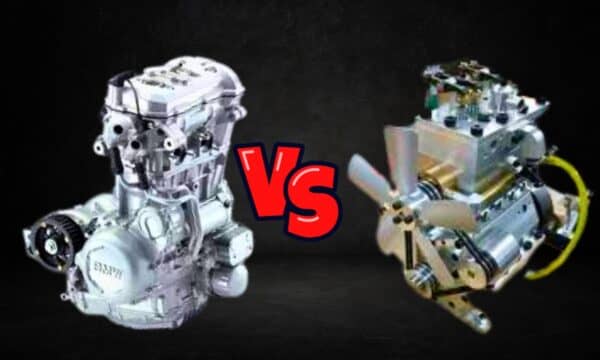When it comes to motorcycle engines, the debate between Parallel Twin and Inline Twin engines is a classic one, attracting diverse opinions from enthusiasts and experts alike.

Both configurations have their unique characteristics, advantages, and drawbacks, contributing to the riding experience in different ways.
In this article, we will compare their performance, design, and overall feel to understand Parallel Twin vs Inline Twin engines.
Parallel Twin Engine Vs Inline Twin – Overview
The debate between Parallel Twin and Inline Twin engines is a longstanding one among motorcycle enthusiasts.
The Parallel Twin, characterized by its two vertical cylinders side by side, is known for its exceptional balance and smooth operation.
On the other hand, the Inline Twin, with its two horizontal cylinders arranged in a line, is lauded for its compact design and torquey performance.
Both have their distinct advantages and trade-offs, making the choice largely a matter of personal riding preferences and specific biking needs.
Parallel Twin Engine
Configuration
The configuration of a parallel twin engine refers to its unique design where the two cylinders are placed side by side.
This layout is not only compact but also balanced, which reduces vibration and leads to smoother operation. A Parallel Twin Engine has two cylinders, resulting in balanced power delivery.
This engine configuration is commonly used in motorcycles to achieve a narrower profile, improving handling and rider comfort.
Vibration and Balance
In the context of a parallel twin, the two cylinders are placed side-by-side, resulting in a configuration that provides a balanced and smooth operation due to the equal weight distribution.
However, this layout can produce a certain amount of vibration, primarily due to the fact that both pistons move together in the same direction.
The vibration is often mitigated by using a balancing shaft, which rotates in the opposite direction to the crankshaft, effectively reducing the level of vibration felt by the rider.
Therefore, achieving a balance between the engine’s vibration and its overall balance is integral to optimizing the performance and comfort of a motorcycle powered by a parallel twin engine.
Power Delivery
The power delivery of a parallel twin engine is distinct and characterized by its linear, smooth, and predictable nature.
This type of engine configuration delivers a consistent torque curve, ensuring that power is readily available across a wide range of RPMs.
Consequently, it provides you with a sense of control and stability, particularly during acceleration and when navigating through traffic.
The parallel-twin engine’s power delivery system is not only ideal for novice riders due to its manageable and forgiving nature but also appeals to experienced riders seeking a balance of power, performance, and practicality.
Sound and Character
The Parallel Twin Engine possesses a unique sound and character that sets it apart in the realm of motorcycles.
It generates a characteristic exhaust note, a deep, throaty roar that resonates with the rhythm of the ride. This sound is the result of its distinct firing order and, to many enthusiasts, it’s music to their ears.
The character of a Parallel Twin Engine is defined by its smooth delivery of power. The balance of the two cylinders results in less vibration, offering a more comfortable ride.
This engine configuration delivers a harmonious blend of performance and rider comfort, creating an exhilarating riding experience that’s hard to match.
Size and Weight
When it comes to size and weight, a parallel twin engine strikes the perfect balance, offering a compact and lightweight design that doesn’t compromise on power.
This type of engine configuration is characterized by its two-cylinder arrangement, which contributes to its relatively smaller size compared to other engine types.
This compactness, coupled with its lightweight, makes a parallel twin an ideal choice for motorcycles, ensuring ease of handling, better fuel efficiency, and improved maneuverability.
The minimized weight also contributes to enhanced performance, particularly with acceleration and top-speed capabilities.
Cooling
The parallel-twin engine employs a liquid-cooling system, which is the most common cooling method used in modern motorcycles. This system utilizes coolant fluid to absorb the heat generated by the engine, ensuring its optimal performance and longevity.
The coolant circulates through the engine block, absorbing heat, and then passes through a radiator, where the heat dissipates into the surrounding air.
This continuous cycle effectively maintains a consistent engine temperature, preventing overheating and potential damage.
Applications
Parallel twin engines are commonly employed in the automotive industry, specifically in motorcycles, due to their compact size, balance, and power delivery.
They can be found in various models of sport and touring bikes, offering a smooth and responsive ride. These engines are also utilized in small cars and light aircraft, offering reliability and efficient power output.
Some manufacturers use parallel twin engines in portable generators because of their consistent energy production and fuel efficiency.
Inline Twin Engine
Configuration
The configuration of an inline twin engine refers to its design and arrangement. In this setup, two cylinders are arranged in a line, one behind the other, along a single crankshaft.
This linear arrangement contributes to the engine’s compact size, making it an ideal choice for small to mid-sized vehicles.
Moreover, the inline twin engine configuration also results in smoother operation due to the balance of forces, provided the firing order and crankshaft design are well-executed.
Vibration and Balance
These engines are designed with two cylinders aligned in one row, which can cause a degree of vibration due to the pistons’ reciprocating motion.
To mitigate this, balance shafts might be used to counteract the forces and help smooth out the engine’s operation.
This not only improves the overall performance but also enhances the user’s comfort and the engine’s longevity by reducing wear and tear.
Power Delivery
When it comes to power delivery, the inline twin engine shines with its ability to provide consistent, smooth, and efficient power throughout the rev range.
This is enabled by the engine’s unique design that facilitates a steady power output, which in turn contributes to an enhanced driving or riding experience.
The configuration of the cylinders ensures a high level of balance, often reducing the need for a balancing shaft.
As a result, you can expect a reduction in power loss, an increase in fuel efficiency, and a smoother, more balanced ride.
Sound and Character
The sound and character of an inline twin engine are truly unique. The engine, with its two cylinders, produces a distinctive, usually even firing, pleasing sound that is often compared to a rhythmic, pulsating beat.
This is because the firing sequence of the cylinders is evenly spaced, creating a smooth, continuous rhythm. This sound is a major aspect of the engine’s character, reflecting its power and dependability.
The inline twin engine’s character is also defined by its smooth performance and reliability, making it a favorite amongst automotive enthusiasts.
Size and Weight
The size and weight of an inline twin engine are among its most significant advantages. Compactness is key, where the two cylinders are arranged in a line, one behind the other, resulting in a significantly reduced width. This allows the engine to fit into tighter spaces than other configurations.
An inline twin engine typically weighs less than its multi-cylinder counterparts, contributing to overall vehicle weight reduction and, thus, improved fuel efficiency.
These characteristics make the inline twin engine a favored choice for smaller vehicles such as motorcycles and compact cars.
Cooling
The inline twin engine uses a liquid cooling system to regulate its temperature. This system involves the circulation of coolant, typically a mixture of water and antifreeze, around the engine block and cylinder head.
The coolant absorbs the heat generated by the engine, and the heated fluid then passes through a radiator, where the heat is dissipated into the surrounding air.
This convection process ensures that the engine operates at an optimal temperature, preventing overheating.
Applications
Inline twin engines are extensively utilized in the automotive, aviation, and marine industries due to their compact size and efficient performance.
In the automotive sector, they are often found in small to medium-sized motorcycles, contributing to their lightweight and maneuverability.
In aviation, the use of inline twin engines is common in light aircraft where weight and space are at a premium. Similarly, in the marine industry, these engines are employed in smaller vessels, leading to optimal fuel efficiency and power-to-weight ratio.
The versatility of inline twin engines extends to power generators as well, where they offer a reliable and consistent power supply.
Which Is Best, Parallel Twin Engine Vs Inline Twin
When it comes to engine configurations, the debate between parallel twins and inline twins is a common one among automotive enthusiasts.
The parallel-twin engine has its two cylinders placed side by side.
This configuration is known for its balance, smooth operation, and compactness, making it ideal for smaller vehicles like motorcycles.
The vibrations are significantly less in parallel twins due to dual mass balancing, which results in enhanced rider comfort.
On the other hand, the inline twin, with its cylinders arranged in a line, is less commonly used. It tends to generate more vibration and is typically larger, making it less ideal for compact applications.
However, it can provide more power, making it a potential choice for larger vehicles.
Thus, while the parallel-twin engine is generally deemed superior due to its balanced operation and compact nature, the inline twin is not without its merits, particularly in applications where more power is needed.
You can also check Milwaukee 107 Vs 103, Milwaukee 107 vs 114, Parallel-twin vs V-twin and the major differences between V6 and 6-cylinder engines.

Ahtsham Younas is a passionate blogger and content writer. He loves to ride motorcycles and learn the mechanical process behind the motorcycles.
He has been writing articles in the motorcycle industry since 2019 and has learned many things about motorbike niches.


